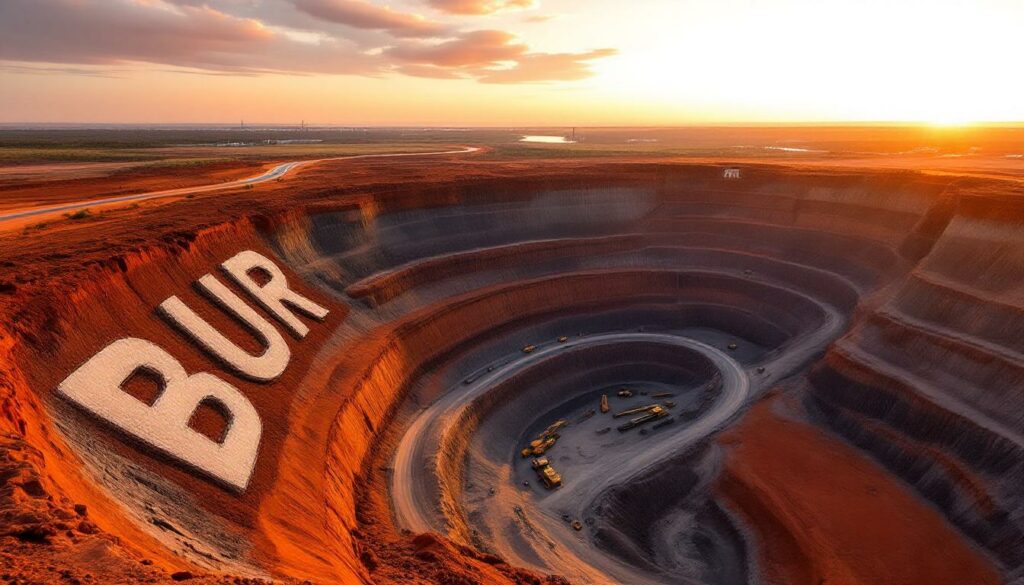Maiden Iron Ore Drilling Success for Burley Minerals at Cane Bore Project
Burley Minerals (ASX: BUR) has announced promising assay results from its maiden reverse circulation (RC) drilling program at the Cane Bore Iron Project in Western Australia's Pilbara region, revealing significant iron mineralization at surface extending to depths of 9 meters.
Drilling Confirms Promising Iron Grades Near Surface
The maiden iron ore drilling at Burley Minerals Ltd comprised 28 drill holes totaling 1,020 meters, testing Channel Iron Deposit (CID) mineralization across 2.3 kilometers of strike length covering an area of 80 hectares.
Key intercepts included:
- 3m @ 54.0% Fe (60.0% calcined Fe) in hole CBRC005
- 4m @ 51.1% Fe (57.5% calcined Fe) in hole CBRC010
- 2m @ 50.7% Fe (57.7% calcined Fe) in hole CBRC010
- 3m @ 50.7% Fe (57.6% calcined Fe) in hole CBRC008
- 4m @ 50.0% Fe (56.2% calcined Fe) in hole CBRC012
The drilling program achieved a maximum iron grade of 54% Fe (62.2% calcined Fe), with an average of 49.6% Fe (56.0% calcined Fe) at a 47% Fe cut-off grade, confirming the presence of quality iron mineralization. Similarly, Great Boulder Resources has announced new gold targets at their Side Well Project, showcasing the active exploration landscape in Western Australia.
Strategic Location With Infrastructure Advantages
The Cane Bore Iron Project enjoys a strategic location in Western Australia's Pilbara region, renowned for world-class iron ore deposits. Importantly, the project is situated less than 100km by sealed road from the Port of Ashburton and the town of Onslow, adjacent to the sealed Northwest Coastal Highway.
This favorable location could provide Burley with significant logistical advantages compared to more remote iron ore projects, potentially reducing future development and transportation costs.
"The assay results from the maiden drilling programme at Cane Bore's South Target are very encouraging. In addition to the surface mineralisation, we are seeing mineralisation at depth which bodes well for drilling the larger targets to the northeast," stated Managing Director and CEO Stewart McCallion.
Understanding Channel Iron Deposits (CID)
Channel Iron Deposits represent a specific type of iron formation common in the Pilbara region of Western Australia. These deposits formed during the Tertiary period (approximately 2-65 million years ago) when iron-rich materials eroded from surrounding landscapes and accumulated in ancient river channels.
As rivers changed course over time, these iron-rich deposits remained as elevated features in the landscape, often appearing as mesa-like formations standing above surrounding terrain. This is why CIDs typically form distinctive ridges or plateaus that can be identified in topographic surveys.
The iron minerals in CIDs primarily consist of goethite and hematite, which are cemented together with varying amounts of clay and other materials. These deposits typically contain iron grades ranging from 45-58% Fe, making them economically viable for mining when located near infrastructure.
The presence of clay layers within the CID structure, as observed in Burley's drilling results, is a common characteristic of CID resources in the West Pilbara region and doesn't necessarily detract from the deposit's potential value. In fact, Vital Metals recently secured funding for their rare earths project, highlighting investor interest in diverse resource opportunities.
Aggressive Exploration Timeline Ahead
With assay results from the maiden iron ore drilling at Burley Minerals Ltd now confirmed, the company is moving quickly to expand its exploration program:
- A heritage survey at the North and Step-Out Targets is scheduled for July 2025
- Maiden drilling at these targets is planned for August 2025, with all required permits already in place
The North and Step-Out Targets represent a significantly larger exploration opportunity than the South Target, covering a combined area of more than 290 hectares (2.9 million square meters) with a contiguous ridge of CID mineralization extending over five kilometers of strike length.
Investment Thesis: Early-Stage Exposure to Iron Ore With Infrastructure Advantages
Burley Minerals offers investors exposure to an emerging iron ore story with several compelling attributes:
-
Strategic Location: The project's proximity to existing infrastructure, including sealed roads and the Port of Ashburton, provides a significant competitive advantage.
-
Exploration Upside: The South Target represents less than 25% of the total target area permitted for drilling (3.7 million square meters), suggesting substantial growth potential.
-
Promising Initial Results: The maiden drilling program has confirmed quality iron grades from surface to depths of 9 meters, validating earlier surface sampling.
-
Clear Development Path: With a structured exploration program and all required permits in place, Burley has established a clear timeline for advancing the project.
Why Investors Should Follow Burley Minerals
For investors seeking exposure to the iron ore sector, Burley Minerals represents an opportunity to gain ground-floor access to a project with substantial exploration upside in one of the world's premier iron ore regions. The company's advantageous location near existing infrastructure could potentially accelerate the path to development if exploration continues to yield positive results.
With an active iron ore drilling at Burley Minerals Ltd program planned for the coming months and the prospect of testing significantly larger target areas, Burley Minerals is positioning itself as an emerging player in the Western Australian iron ore landscape. Furthermore, companies like Sunshine Metals have intercepted promising gold-silver veining at their Tigertown project, demonstrating the diverse mineral potential in Australian resource sectors.
The approved exploration Programme of Work comprises more than 150 drilling locations across three CID target areas on the East Flank: South Target, North Target and Step-Out Target. The combined area of these targets exceeds 370 hectares (3.7 million square meters), with elevations rising more than 20 meters above surrounding ground levels.
This systematic approach to exploration demonstrates the company's commitment to thoroughly evaluating the project's potential and establishing a solid foundation for future development decisions. In addition, other companies in the region like Mt Fisher have identified early gold production opportunities from stockpiles, highlighting various approaches to resource development in Australia.
As Burley advances its iron ore project, the company joins others like Inca Minerals who recently gained majority control of their acquisition target, showing the active mergers and acquisitions environment in the Australian resources sector.
Interested in Discovering the Next Major Iron Ore Opportunity?
Stay ahead of promising ASX mineral discoveries like Burley Minerals' Cane Bore success with real-time alerts from Discovery Alert's proprietary Discovery IQ model, helping investors identify actionable opportunities before the broader market. Explore historic returns from significant mineral discoveries by visiting the Discovery Alert discoveries page and begin your 30-day free trial today.




